Fractal Design Define Mini Case Review
by Dustin Sklavos on April 22, 2013 12:01 AM EST- Posted in
- Cases/Cooling/PSUs
- MicroATX
- Fractal Design
- Case
Noise and Thermal Testing
In a bid to focus on providing only useful information and keeping things clean, simple, and to the point, I've culled idle thermal test results from this review (and will from reviews going forward). Idle thermals are borderline irrelevant, and only important when they're comically high; at idle, the most important statistic is noise.
As I mentioned on the Testing Methodology page, due to retiring the micro-ATX board from the primary testbed, micro-ATX cases will now be tested with the mini-ITX testbed. That means that I can't compare the Fractal Design Define Mini directly against the SilverStone SG09 and the Rosewill Line-M. As it turns out, that may not be as big of an issue as it first appears.
The Fractal Design Define Mini was tested with the included fan controller at its lowest and highest settings. Ambient temperature ranged between 22C and 25C during testing.
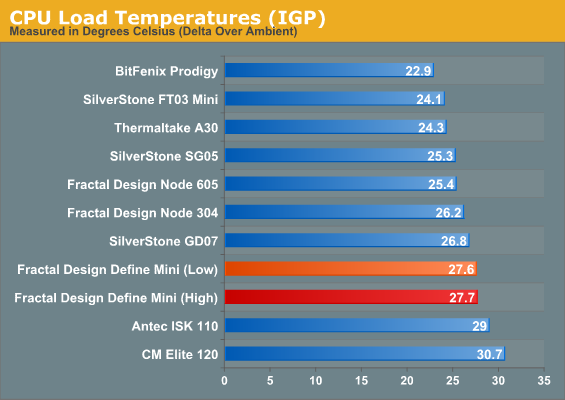
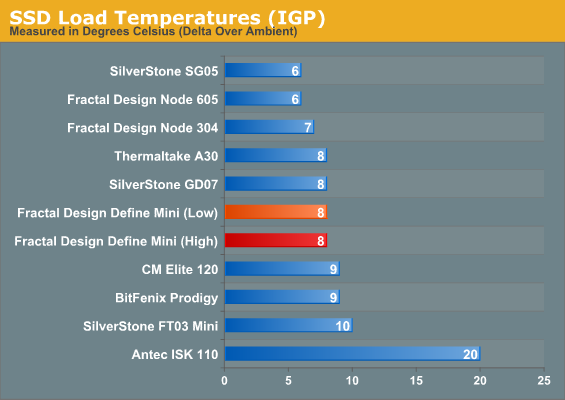
Already things aren't looking that great for the Define Mini. Changing the fan setting doesn't do a whole lot fo the CPU, but the system just isn't very good at keeping the CPU cool. In Fractal Design's defense, this case looks better suited to a tower-style cooler, but as you'll see later, the problem may not be simply a cooler not being right for the case.
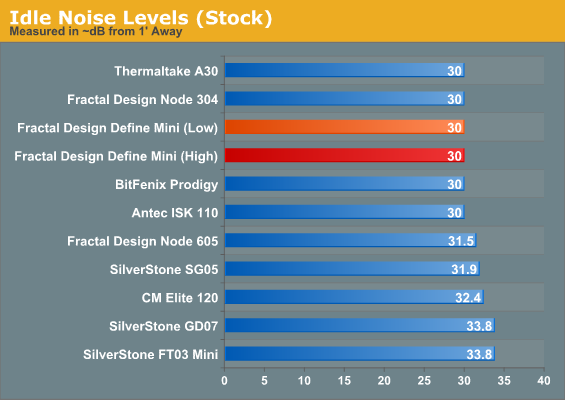
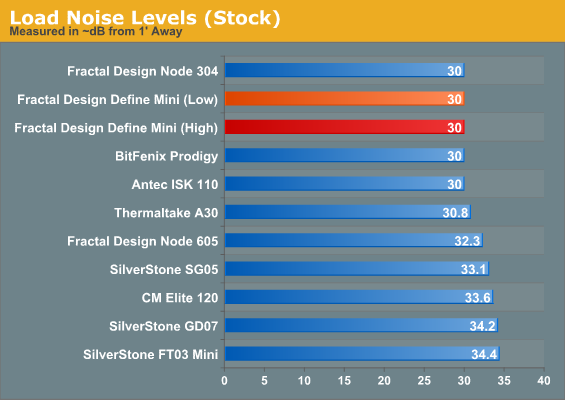
While the highest fan setting is definitely louder than the lowest, it's not tremendously slow, and it's still below the 30dB floor of our sound meter. If nothing else, in our barebones stock configuration, the Define Mini is very quiet.
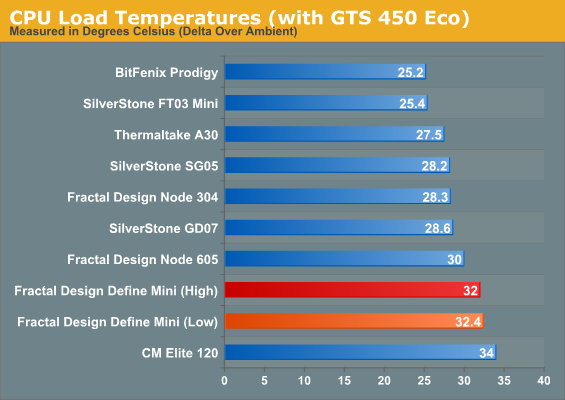
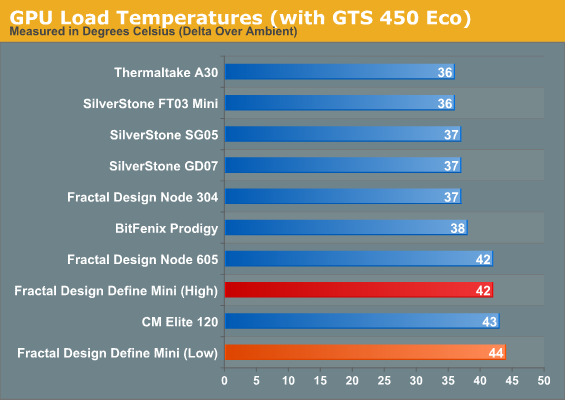
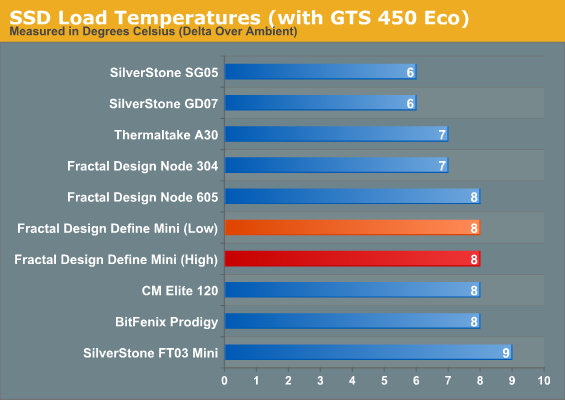
Ordinarily adding a dedicated graphics card will bump the CPU temperatures up a couple of degrees (sometimes it actually can reduce them a little since the IGP is no longer in use). Not so, here. The GTS 450, typically a model citizen, just makes a bad situation worse. And despite having direct airflow from the front intake, it still runs hotter than the bulk of the cases tested.
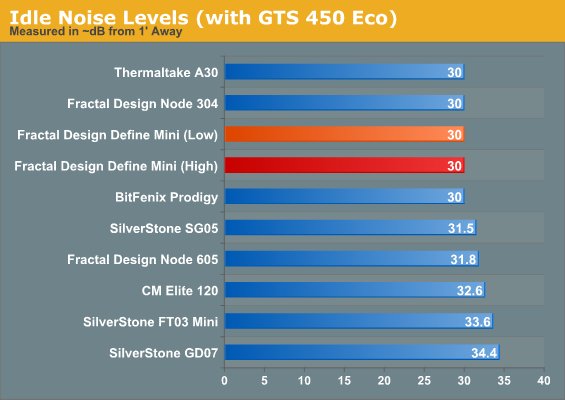
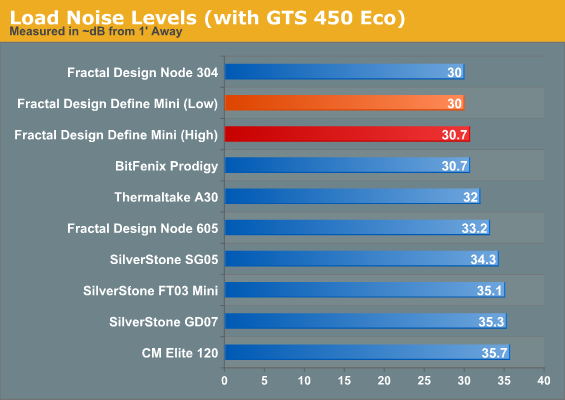
Noise levels continue to be low, but they can't really make up for the consistently poor performance of the stock fans in the Define Mini. Bumping the graphics card up to a bigger monster like the GTX 560 Ti does seem to help at least a little, though.

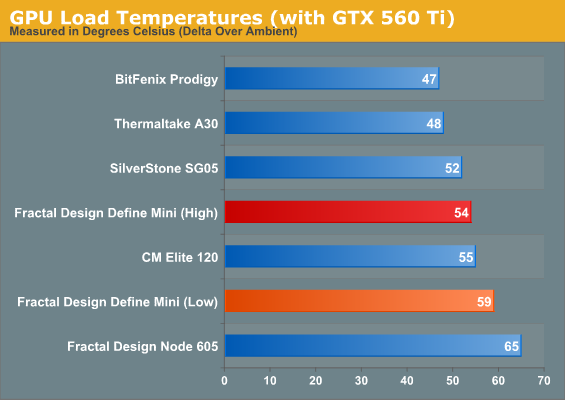

Comparative performance improves some and the two fan settings start to really separate. While not strictly comparable to results from the main testbed (which has an extra 30W of CPU heat to dissipate alongside the 560 Ti), the graphics card's performance is now at least competitive. CPU thermals continue to underwhelm, though, with the highest fan setting being required to produce decent results.
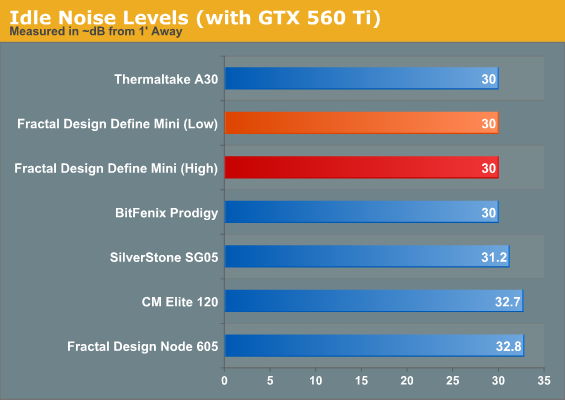
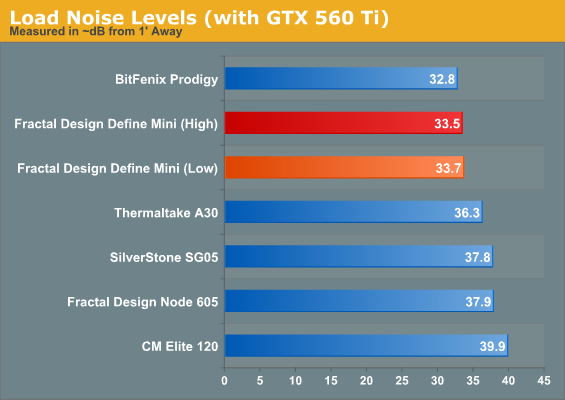
The Define Mini does a strong job of proving its worth once the noise results come in, though. Things are running pretty warm, but they're reasonably quiet, too. At idle the system remains inaudible, while load noise is fairly low. This is one of those instances where a higher case fan speed can actually produce lower noise, though, as the graphics card's fans don't need to spin as fast to move cool air over the GPU.










57 Comments
View All Comments
antef - Monday, April 22, 2013 - link
Agreed, dimensions are the first thing I check for any MicroATX case now, if it's no smaller than most ATX cases then why would I even consider it? I hope manufacturers are reading this. Many of us don't have that many components and don't require these dimensions.takeship - Monday, April 22, 2013 - link
I can vouch for this. It's FAR too large a case for what it offers. I've built twice with this case, once for myself and once for a friend - in retrospect the thermals vs noise don't justify this over a full Define R4, or one of the recent NZXT Phantoms. Mostly high quality, though the motherboard cut out is the wrong size for virtually any backplate, and the included fan controller was junk, and well, I replaced every fan anyways. Further, there is *barely* enough space to fit a Crossfire/Sli dual slot setup in the case with the tight clearance above the PSU standoff. I only have a single card, so it's less of an issue, but there is very little airflow from the front case fans through the non-removable lower HDD bay into the GFX card space. Living with it for now, and the heft makes it feel secure, but I wouldn't recommend it for a real enthusiast.dave_the_nerd - Monday, April 22, 2013 - link
Quote: "It's a weird situation when the micro-ATX form factor seems to be ideal for the majority of end users."Umm... what?
The majority of PC end users buy laptops. (Laptops outsell desktops by about 2:1.) Most of those desktops are sold to businesses, and it's literally been years since I saw an ATX or mATX minitower in use in somebody's home. (Mostly SFF desktop designs and iMacs.)
Today, mATX is the answer to a question anybody asked. The BYO "enthusiast" crowd will continue buying ATX towers with room for all their cooling hardware, and the BYO "best fit for my needs" crowd will continue snatching up SFF.
marc1000 - Monday, April 22, 2013 - link
Hi Dustin! you say you have a terrible time to manage cables on every case you test, but how do you feel about cabling a custom-case made by hp?I'm living with it because it is mATX and is much smaller than the average cases on stores. I don't have the exact dimensions now, but I managed to change all internals, add one SSD, a scythe Ninja Mini cooler, and even a Radeon 5770 in there. with all fans being PWM this thing is pretty quiet, at iddle you can hear it but it's not annoying. at load however the GPU fan makes a bunch of noise :(
here are some images from a similar case from the HP site.
outside: bit.ly/ZE9Bge
inside: bit.ly/ZEaQMr
how would you feel about doing cabling this one? lol
marc1000 - Monday, April 22, 2013 - link
short url corrected:http://goo.gl/QCjpd
http://goo.gl/PhBJZ
ZoeAnderson24 - Monday, April 22, 2013 - link
If you think Ronald`s story is surprising..., a month back my cousins best friend basically recieved a check for $8905 working a 40 hours month at home and they're friend's mother-in-law`s neighbour has been doing this for 7-months and made over $8905 in there spare time on there labtop. follow the instructions from this web-site. All29.comCHECK IT OUTjrs77 - Monday, April 22, 2013 - link
Testing cases is really a hard thing to do I'm afraid.I've got the Define Mini on my desk behind my screen, where it hides itself due to it's little height.
Anyways... for the watercooling. A 240mm rad in the front is possible without modding. Just remove the two drivebays and install your 3.5" HDD + 2.5" SSD in one of the 5.1/4" bays. Another 120mm rad is possible in the back, so you have one 240mm rad for the GPU and one 120mm rad for the CPU, and voilá... even lower temps and the same low level of noise. Install a Scythe S-Flex @ 800RPM in the bottom behind the PSU and one in the top for that little additional ventilation and you can even use powerful components.
I'm running a GTX660 and an i5-3450 in my Define Mini, and temps are no issue at all, and the case is still dead-silent there behind my screen. The one thing I did tho was to cutout the grill covering the fan in the back, as these hex-grills produce a very annoying noise when air is pushed through.
A TJ08-E with a 200mm rad in the front and a 120mm in the back is deadsilent aswell, but a little bit trickier to assemble and crammed.
bsix - Monday, April 22, 2013 - link
Dustin,You seem down on the Define cases except for the Xl r2. What separated that case was a bottom fan. I feel this design really needs that airflow with low impedance to help even out flows, otherwise there is a bit of a dead zone in the bottom half of the case.
Also have we seen a comparison of an air cooled vs water cooled case at Anandtech? I'm not sure I have seen one with some of the later packaged water coolers..
barry spock - Monday, April 22, 2013 - link
It must've been out for more than a year because I got this in Sept(?) of '11. I used it in my first real build for more than 10 years and all up I like it, although I don't know how it compares to others.The aim for me was to build a silent PC. I went for a Noctua fan as well (as someone else in the comments mentioned). It's pretty quiet but in hindsight I think what I should've done is make a no-fan HTPC.
rvdbos - Monday, April 22, 2013 - link
$99 for an empty box? wtf, is it year 1995? nowadays I could get TWO bluray players with remote, ethernet, buildin wifi and DLNA for this much dough. why even bother bringing such a ripoff to the market?